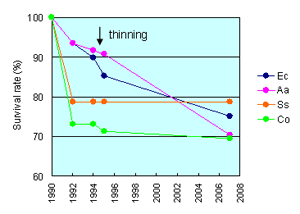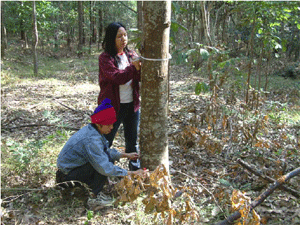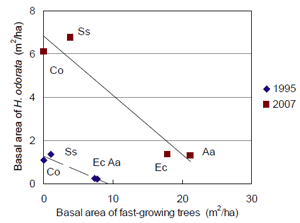Efficient techniques for growing indigenous tree species in combination with fast-growing trees
Description
Against the background of shortages of natural forest resources in tropical areas, the establishment of a cultivation method for indigenous tree species is an urgent matter. We improved on the existing silvicultural techniques by applying the two-storied forest management technique (Upper-story: fast-growing trees, lower-story: indigenous trees) in Northeast Thailand.
In the experimental plot, the dipterocarp indigenous tree, Hopea odorata, was planted in 1990 after three fast-growing tree species were planted with four different spacing regimes in 1987. To promote the growth of H. odorata, 50% of thinning was applied to the fast-growing trees in 1994. Then, we re-surveyed the experimental plot in 2007 and collected tree data and analyzed them together with the previous data. Eucalyptus camaldulensis and Acacia auriculiformis showed high growth rate recordings at 8.8-11.3 m3/ha/year in terms of mean annual increment (MAI) in the stem volume, while Senna siamea showed only 1.0-1.3 m3/ha/year. The survival rate of H. odorata was relatively high in the eucalyptus and acacia plantations but it decreased gradually by 2007 due to the shading by the canopy of the fast-growing trees. However, the survival rate of H. odorata remained high in the S. siamea plantation although it decreased rapidly in the beginning (Fig. 1). The growth of H. odorata was vigorous in the S. siamea plantation especially at the spacing of 2 m x 8 m (Fig. 2), exceeding the growth of the H. odorata trees planted in the open site (control plot). A negative relationship (trade-off relationship in ecological term) was observed between the basal area of fast-growing trees and those of H. odorata (Fig. 3). This result implies that the growth of H. odorata will be improved if fast-growing trees will be removed properly by thinning or clearcutting. We estimate that H. odorata will grow well even in a eucalyptus or acacia plantation, if the total basal area is limited to around 5 m2/ha.
These findings suggest that H. odorata can grow well in combination with some fast-growing trees thereby providing different kinds of wood products in different periods, which will bring more profits for the forest planters (i. e. farmers). Moreover, planting dipterocarp tree species will bring another source of income for farmers such as the production of edible fungi which form mycorhiza in the roots of dipterocarp trees.
Figure, table
-
Fig. 1 Changes in survival rates of Hopea odorata planted in various fast-growing tree plantations.
Ec: with Eucalyptus camaldurensis, Aa: with Acacia auriculiformis, Ss: with Senna siamea, Co: control (no fast-growing tree) -
Fig. 2 A 17-year-old Hopea odorata planted in the Senna siamea plantation -
Fig. 3 Relationships between the basal area of fast-growing trees and those of H. odorata -
- Affiliation
-
Japan International Research Center for Agricultural Sciences Forestry Division
- Classification
-
Technical A
- Term of research
-
FY2008(FY2006~2010)
- Responsible researcher
-
SAKAI Atsushi ( Forestry Division )
VISARATANA Thiti ( Forest Research and Development Bureau, Royal Forest Department, Thailand )
Vacharangkura Tosporn ( Forest Research and Development Bureau, Royal Forest Department, Thailand )
- ほか
- Publication, etc.
-
Sakai et al. (2008) Abstracts of the 119th annual meeting of the Japanese forest society, p318.
Sakai, A., Visaratana, T., Vacharangkura, T., Chiba, Y. and Nakamura, S. (2008) Experiments of uneven-aged forest plantation combining fast-growing trees and indigenous trees in northeast Thailand. Abstracts of the Conference on Feasibility of Silviculture for Complex Stand Structure, p106.
Sakai, A., Visaratana, T., Vacharangkura, T., Thai-ngam, R., Tanaka, N., Ishizuka, M. and Nakamura, S. (2009) Effect of species and spacing of fast-growing nurse trees on growth of an indigenous tree, Hopea odorata Roxb., in northeast Thailand. Forest Ecology and Management 257, 644-652.
- Japanese PDF
-
2008_seikajouhou_A4_ja_Part22.pdf616.64 KB



